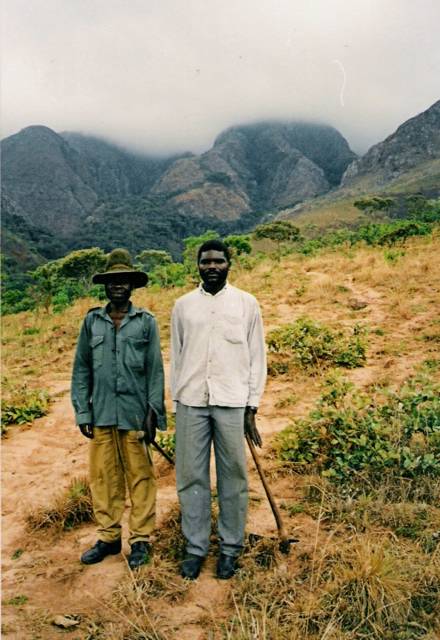COMMUNITY-BASED NATURAL RESOURCE MANAGEMENT
I did a number of projects in support of the Community-Based Natural Resource Management (CBNRM) Project. These projects ranged from assisting with village tree nurseries, to establishing a training program for frontline forestry department staff. I did projects in agriculture: advanced fruit tree farming, macadamia, and soil conservation. I did other projects with women's groups mostly to do with cooking and nutrition which grew out of an interest of mine to start a cooking club in Chisenga.
I determined early on that I could spend my whole two years doing proposal writing and tracking funds and receipts (which would have been difficult as it normally took me two days to get to the nearest bank in Karonga), and I did not have electricity, a phone line, nor a computer. But, also, I observed that villagers were already running around from project to project merely in the hopes of getting invited to a workshop. When asked "How was the workshop?" The answer would be "I got K500 per day."
Perhaps I am justifying; maybe I was just being lazy to do proposal work. But, it seemed to me that to get some good work done in my short 2 year timeframe, and afterall 2 years is very short in the life of a tree, I should not waste my time running to and fro just to throw money at people.
I did projects sans funding, and therein lies the truth of the matter, I had to do projects that people wanted to do, for themselves. The projects we did stuck to 3 major themes: agriculture, income generating activities, and cooking new foods. Macadamia was perfect, it was discovered by my counterpart (by reading about it in one of my horticulture magazines), and fit in all three of the above themes. The problem was the long time scale and complexity. The good news was that our area was suitable (within Chitipa: along Mafinga Hills, the highlands of Wenya, and Misuku Hills).
But, lets go back to the environment. The idea of CBNRM is that communities could manage their own natural resources, they are the closest to them, have local methods for sustainably using resources (ideally), and could through committees and local leadership set their own boundaries, keeping the resources and any fines imposed, local. Now, villagers I discussed this with, thought this was some kind of nasty trick. Only one or two of the villages (out of dozens) had ever been trained. The constant argument that I heard from defunct Village Natural Resource Management Committee (VNRMC) members was that they needed to be trained. I tried to meet with some of these previously formed groups and never had any success, the interest level appeared to be too low (and I didn't offer any workshop allowance).
Not only that, but groups felt that this was the job of the forestry department, and that they had enough issues on their plates. They had already seen the old forestry department tree nuseries disappear, now they were expected to do their own. They no longer received money to do boundary clearing (for the forest reserve). Now further still they were expected to police their own reserves and village forest areas (VFAs) and not even get paid for it. What was the forestry staff being paid for?
Well, enough on that subject for now. I'll post later on projects that did seem to work.
I determined early on that I could spend my whole two years doing proposal writing and tracking funds and receipts (which would have been difficult as it normally took me two days to get to the nearest bank in Karonga), and I did not have electricity, a phone line, nor a computer. But, also, I observed that villagers were already running around from project to project merely in the hopes of getting invited to a workshop. When asked "How was the workshop?" The answer would be "I got K500 per day."
Perhaps I am justifying; maybe I was just being lazy to do proposal work. But, it seemed to me that to get some good work done in my short 2 year timeframe, and afterall 2 years is very short in the life of a tree, I should not waste my time running to and fro just to throw money at people.
I did projects sans funding, and therein lies the truth of the matter, I had to do projects that people wanted to do, for themselves. The projects we did stuck to 3 major themes: agriculture, income generating activities, and cooking new foods. Macadamia was perfect, it was discovered by my counterpart (by reading about it in one of my horticulture magazines), and fit in all three of the above themes. The problem was the long time scale and complexity. The good news was that our area was suitable (within Chitipa: along Mafinga Hills, the highlands of Wenya, and Misuku Hills).
But, lets go back to the environment. The idea of CBNRM is that communities could manage their own natural resources, they are the closest to them, have local methods for sustainably using resources (ideally), and could through committees and local leadership set their own boundaries, keeping the resources and any fines imposed, local. Now, villagers I discussed this with, thought this was some kind of nasty trick. Only one or two of the villages (out of dozens) had ever been trained. The constant argument that I heard from defunct Village Natural Resource Management Committee (VNRMC) members was that they needed to be trained. I tried to meet with some of these previously formed groups and never had any success, the interest level appeared to be too low (and I didn't offer any workshop allowance).
Not only that, but groups felt that this was the job of the forestry department, and that they had enough issues on their plates. They had already seen the old forestry department tree nuseries disappear, now they were expected to do their own. They no longer received money to do boundary clearing (for the forest reserve). Now further still they were expected to police their own reserves and village forest areas (VFAs) and not even get paid for it. What was the forestry staff being paid for?
Well, enough on that subject for now. I'll post later on projects that did seem to work.







